- Italy Tours Home
- Italy Ethos
- Tours 2023
- Blog
- Contact Us
- Dolomites
- Top 10 Dolomites
- Veneto
- Dolomites Geology
- Dolomiti Bellunesi
- Cortina
- Cadore
- Belluno
- Cansiglio
- Carso
- Carnia
- Sauris
- Friuli
- Trentino
- Ethnographic Museums
- Monte Baldo
- South Tyrol
- Alta Pusteria
- Dobbiaco
- Emilia-Romagna
- Aosta Valley
- Cinque Terre
- Portofino
- Northern Apennines
- Southern Apennines
- Italian Botanical Gardens
- Padua Botanical Garden
- Orchids of Italy
The Bologna Apennines: Plentiful Nature Two Steps’ Away from the City.
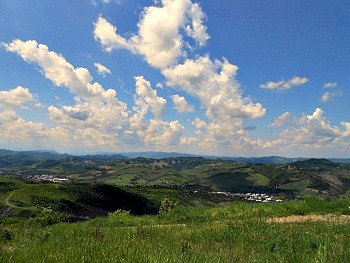
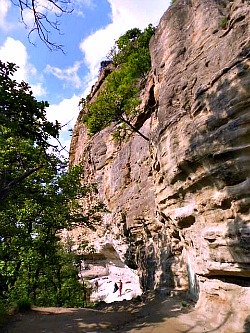
The territory of the Bologna Apennines – the hills and mountains south of Bologna, Emilia-Romagna’s regional capital – has been modeled over the centuries by man into a mosaic of cultivated fields, pastures, shrubby habitats and woodland, and it is still rich in areas of high naturalistic value, located especially in those situations less disturbed by human activity – such as valley bottoms, dolines (sink-holes), ‘calanchi’ (typical erosion forms on clayey soils) and rocky outcrops, always in strict relation with the nature of the geologic substrate and morphology (above, see an image of the Bologna Apennines taken from Monte Calvo – a modest elevation immediately to the south of the city, which commands a sweeping view despite its low altitude).
In this respect, a particularly meaningful example is the Pliocenic Rampart (Contrafforte Pliocenico; second picture above): a long sequence of high sandstone cliffs with a mainly southerly aspect, where the nature of rocks, the variations in orography and the pedological substrate – as well as the contrasting micro-climatic situations – all contribute to create a great diversity of environments and habitats that host characteristic flora and fauna with a wide variety of species, some of which are rare.
Vegetation of the Bologna Apennines
The particular geographic location, at the threshold between the Mediterranean and the Middle European floral regions, allows the co-existence of plants which are very different and sometimes typical of faraway landscapes – in some cases found here at the limit of their natural geographic distribution.
Meaningful examples within the more common Mediterranean contingent of plants include Holm oak, Narrow-leaved Phillyrea (Phillyrea angustifolia) and Mediterranean Buckthorn (Rhamnus alaternus), which can be observed on the arid rocks of the Pliocenic Rampart – especially so along the Calvenzano cliff and on the sunnier chalk outcrops – to which are juxtaposed more Northern species like Scot’s Pine (Pinus sylvestris), which in the Regional Park of Monte Sole has its southernmost limit of natural geographic distribution.
In these hills the mixed woodlands represent very interesting habitats, and the flora reserves numerous surprises; the wild fauna is also enriched by many – and sometimes new – presences. In the last decades, in fact, with the abandonment of previously cultivated fields some areas have become less productive, while the minor frequency in the cutting of timber has favoured an increase in surface of the wooded areas; where there wasn’t a massive invasion of alien species – such as Robinia pseudoacacia and Ailanthus altissima – a sensible betterment of the woodland structure and of its floral composition was achieved, to which corresponded an augmented presence of interesting fauna.
Along the slopes with a more southerly aspect the woodland formations are characterized by a prevalence of Pubescent oak (Quercus pubescens), while in the fresher and shadier locations grow formations mainly composed of Hop Hornbeam (Ostrya carpinifolia), Hazelnut (Corylus avellana) and Manna Ash (Fraxinus ornus) instead. In these latter type of woods, the understory is also rich in species that give life to an abundant blossoming of spring flowers, such as Liverwort (Hepatica nobilis), white- (Anemone nemorosa) and yellow- Wild Anemone (Anemone ranunculoides), Dog’s-tooth Violet (Erythronium dens-canis), Alpine Squill (Scilla bifolia) and Lungwort (Pulmonaria officinalis), while in autumn the pink hues of Cyclamen (Cyclamen hederifolia) and Meadow Saffron (Colchicum autumnale) prevail.
In the understory of Pubescent oak woodland – especially in the hills nearer to the plains – is also quite often found Butcher’s Broom (Ruscus aculeatus), while in the more sheltered valleys – especially at the bottom of the dolines – blossom herbaceous species typical of fresher mountain beech woodland, such as Isopyrum thalictroides, Snowdrop (Galanthus nivalis) and Martagon Lily (Lilium martagon): all species which are usually found at higher locations and that are really an unusual – and often rare – sight at these low altitudes.
To the more open and discontinuous meadows are linked also other herbaceous plants and low shrubs which give out rich and colourful blossoms, with many botanical rarities, amongst which stand out various species of Orchids – especially present in the area of the Pliocenic Rampart and in the Regional Park of Monte Sole – and some endemics, such as Campanula bononiensis (Bolognese Bellflower; pictured below).
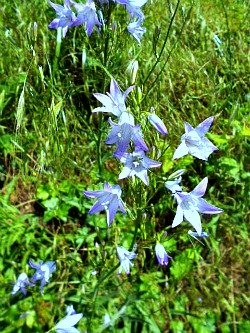
Along the sunnier rocky outcrops prevail instead species with a better capacity to adapt to a harsher environment, amongst which it is possible to recognize some dwarf shrubs rich in essential oils, which give out – especially during the summer months – intense scents; these plants include Helichrysum italicum, various species of Thyme (Thymus ssp.) and Wormwood (Artemisia absinthium), plus minuscule succulent plants – such as those in genus Sedum – and also several species typical of arid climates, like the grasses Pennisetum villosum and Stipa pulcherrima. Even within the severe habitat of the calanchi grow several specialized species, amongst which stand out Ononis masquilleri – an endemic Broom that grows only in restricted areas of the Emilia-Romagna and Marche regions – and the typical crimson spikes of Hedysarum coronarium (Italian Sainfoin; sulla in Italian).
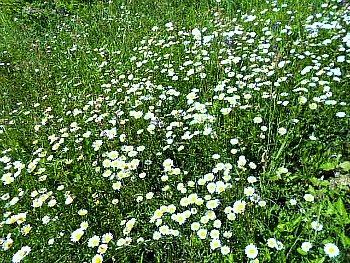
But even without looking very far, the soft landscape of the Bologna Apennines can reserve pleasant surprises, with beautiful displays of the most common flowers: pictured above, for instance, is a beautiful white patch of Common Daisies (Leucanthemum vulgare), while the Val di Zena – a side valley just outside Bologna – is noteworthy for the magnificent display of poppy fields, which can usually be seen in blossom around half May (see the image below).
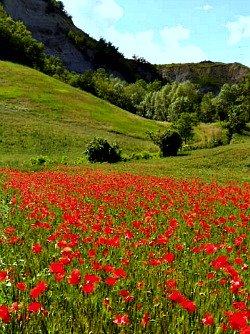
Interestingly, also, some plant species which are considered a rarity in certain countries, here abound. A classic example of this is wild sage – the beautifully violet-coloured Salvia pratensis (Meadow Clary), which is a rare sight in the British Isles and much of Northern Europe, while in the Bologna Apennines it can be found carpeting entire fields (see image below).
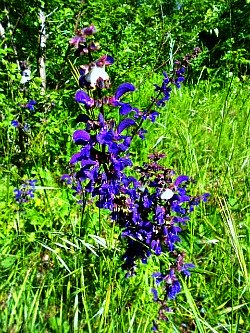
A Few Notes on the Fauna of the Bologna Apennines
A characteristic fauna too finds its home in the most sheltered locations of these hills, and takes advantage of the wide environmental variations created by the mosaic of different habitats that can often be found side-by-side: woodlands, shrubs, small cultivated patches, meadows and thickets derived from the abandonment of previously cultivated areas. Among the vertebrates present here, there is a relevant number of species considered of international relevance – and these figure sometimes also in the European Red List of protected wild fauna.
The most numerous contingent includes birds – both sedentary and nesting species as well as migratory ones. Besides the more ubiquitous birds such as Kingfisher, Alpine Swallow, daytime- (Buzzard, Kestrel, Honey-buzzard and Peregrine falcon) and night-time birds of prey (like Horned Owl and Barn Owl), other notable presences include Woodcock, Quail and White-throat. Among the amphibians – apart from the most common ones like frogs and tritons – more unusual and curious species stand out, like the Apennine Yellow-bellied Toad, whose presence is linked to clay deposits, where it can hide at the bottom of muddy ponds.
The Rat-snake is the most common among the reptiles; other species include Aesculapian snake, Water-snake, Riccioli Adder and Slow-worm. More wooded habitats favour Red Squirrel, Dormouse and other small mammals, while carnivores like Easel and Fox tend to roam more cultivated areas as well as the calanchi.
In the last few years, a gradual expansion in the number of ungulates could also be noticed, especially along the whole length of the lower hilly belt of the Bologna Apennines, just south of the city – in particular Roe Deer and Wild Boar. In more recent times there were also several sightings of Hedgehogs, whose increasing populations have probably strayed north from Tuscany.
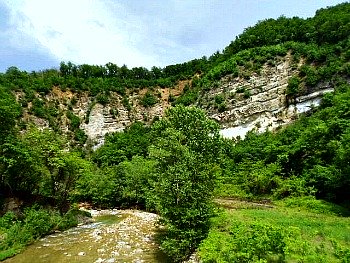
Geologic Highlights of the Bologna Apennines
The Scascoli Gorges
Above the big quarry by which the conglomerates that represent the base of the Inferior Pliocene come to the surface (Monterumici Formation) one can find the so-called Scascoli Gorges (see a picture of the gorges above) – a section of valley deeply cut in the rocky outcrops, at times quite spectacular, and in which one can observe the marls and the calcarenites of the Pantano Formation.
Along the gorge, there is an alternation of levels with different degrees of cementation and granulometry that is further evidenced by selective erosion, which makes particularly evident the thin network of faults that cross the rocks. Corresponding to these faults and small fractures, the layers are displaced for several meters, and if one tries to follow the sequential progress of a single layer both sides of the fault it is not difficult to identify the dislocation that it was subjected to. Near the hamlet of Scascoli are also several old houses, typically flanked by majestic specimens of old oaks (Quercus robur; see the picture below). The delightiful gardens of the Casoncello are also nearby.
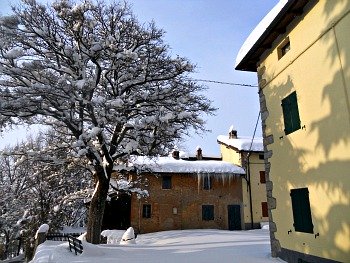
The Anconella Sandstone
In the Bologna Apennines, just south of the city, one can find several locations that define – for a particular type of rock – the area of reference for the geology of the region (the so-called “area tipo” in Italian): this means sites where a geologic unit is exposed and represented in a particularly meaningful way, and hence these places can give their name to the geologic formation.
Therefore, the Anconella sandstone surfaces in a spectacular way along the ridge that dominates the hamlet from which it takes its name. These are rocks of a very pale colour formed mainly of coarse quartz nodules, recognizable for their pale grey colour and the glassy aspect, and feldspar – opaque granules of a pale, milky white colour (below, see an image of the typical dwellings carved into the soft layers of sandstone, near the hamlet of Anconella, from which this formation takes its name).
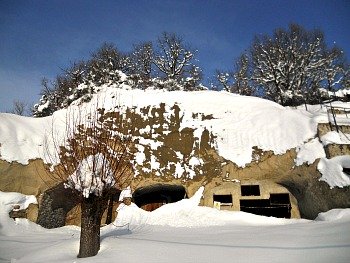
The mineral composition is very similar to the Loiano sandstone (see below): the difference between the two units resides in their stratigraphic position: the Loiano sandstone was deposited in the Middle Eocene, while the Anconella sandstone dates back to the Superior Oligocene (hence it is 10 million of years ‘younger’).
The modalities with which the sandstone arrived on the sea beds put the two formations on a common ground; in both cases, sedimentation happened through turbidity streams. When the Anconella sandstone was generated, the currents were transporting sands which were taken from areas where the more ancient Loiano sandstone was already exposed to erosion (a phenomenon known in geology as ‘cannibalism’): this certainly helps to explain the huge similarity in composition among the two formations. Along these outcrops are present also more cemented rocky sections, with a characteristic rounded shape (these huge pebbles are known as ‘cogoli’ in Italian), whose lining along the rock wall gives good clues as to the direction of the original layers (a typical image of the sandstone layers that can be seen in the area around Loiano is presented below; for the ‘cogoli’, read below).
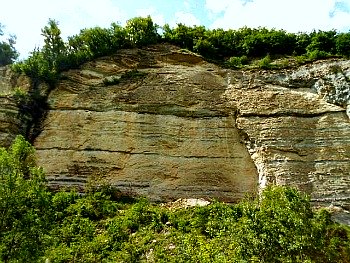
The Loiano Sandstones
The typical area (“area tipo” in Italian) for the Loiano sandstones is one of the most meaningful and better looking, as one of the most interesting outcrops of this formation can be found along the main Futa Road, in correspondence with a sharp bend right at the town entrance, in front of a lay-by where one can easily stop to observe it. Once crossed the road one can get quite near to the actual rock formation, by which it is possible to closely observe the sandstone, mainly formed of coarse quartz granules and feldspar, which make it appear as a uniform compound: amalgamated, undifferentiated and without traces of layers (stratification) or sedimentary structures – with the exception of the thin intercalations of black clays and more cemented parts (‘cogoli’; read below).
Even though it is difficult to reconstruct the environmental conditions that characterized the sea bed at the time when these rocks were deposited, at the base of the outcrop one can easily distinguish a layer formed by voluminous rock fragments of different nature, immersed in a sandy matrix, which indicates that the sedimentation was produced by a thick detritus flux, in which very heavy elements were also transported: this fact allows for the individuation of a depositional event inside this succession of layers. From a detritus flux of this kind, mainly constituted by a mass of water mixed with sand and clay that moved fast towards the deep sea beds, the rapidly transported material was left falling to sediment – and it is from this process that the entire formation of the Loiano sandstone was originated.
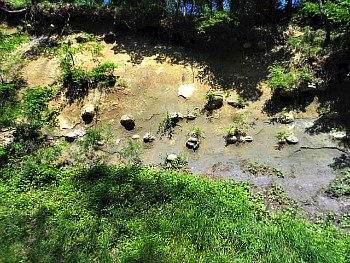
The ‘cogoli’ Walls Along the Zena and Savena Valleys
Along the sandstone rocky walls of the gorges along the Zena and Savena valleys, several layers of ‘cogoli’ are highlighted and stick out of the underlying bedrock: these are hard stones with a rounded shape that represent cemented rocky portions, more solid than the ‘paste’ in which they are immersed (see image above). The origin of the ‘cogoli’ seems connected to areas where calcium carbonate (the ‘natural cement’ of rocks) precipitated into the sandstone interstices with more ease, and started from these first nuclei a process that then advanced in a radial way. The Pliocenic sandstones that contain the ‘cogoli’ were originated in sea beds that are not distant from the original coast line – and this is witnessed by the particular sedimentary structures that can be observed among the layers of ‘cogoli’ (as well as the occasional fossil find).
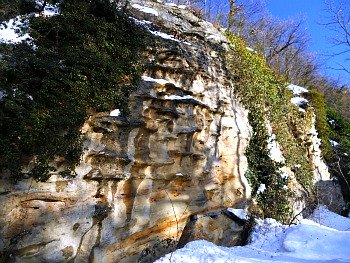
These sedimentary layers are in fact undulated concave-convex shapes (‘hummocky’ stratification) typical of marine environments, where the sands were subjected to elaboration because of ancient storms (see the picture above). During these storm events, in fact, the sea beds were violently shaken, because of the combined action of currents and the oscillation caused by the big storm waves. It is worth focusing, in particular, on the characteristic convex lamination that represent a rarity in the panorama of sedimentary structures, being the product of an interference between the oscillatory motion of the waves and the unidirectional movement of the storm currents.
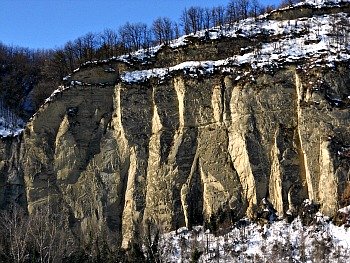
Interesting geologic features are present in almost every corner of the Bologna Apennines; in the Idice valley, for instance, are present the so-called Pizzano gorges, which are again deeply carved into soft sandstone layers (see picture above). This is by far the dominant type of rock in this section of the Apennines, and it gives a predominantly yellowish tinge to the landscape here – especially so in the lower section of the valleys. Very often there also very interesting ice formations that can be seen in winter along these rocks, as they are often found in the coldest – and most shaded – sections of the valleys (see the image below).
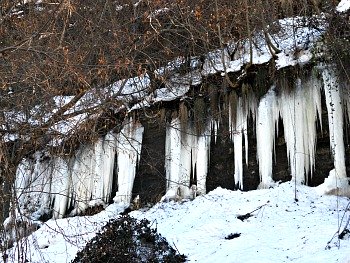
The Pliocenic Rampart
The Pliocenic Rampart (Contrafforte Pliocenico) is a characteristic, long rocky outcrop extended between Livergnano and the Zena valley on one side, and continuing on the other side of the Savena valley towards Monte Adone (654 m), ending up near Sasso Marconi. Although there is a dedicated page on this natural feature, some information is also provided here for completeness (below, an image of the Pliocenic Rampart, as it surfaces in the area around Sasso Marconi).
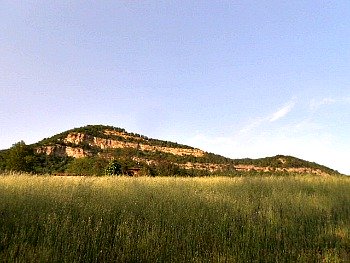
If one walks along the country lane that from the village of Livergnano leads to the hamlet of Sadurano (in the Zena valley), indicated with the usual red-and-white striped CAI markings, one can gain a good perspective on a wide stretch of the so-called Pliocenic Rampart, where interspersed among the sandstone one can see interesting levels of conglomerates. Amongst these, it is possible to focus – in the central section of the rock wall – on a clear example of oblique stratification; one in which the conglomerates are alternated with thin layers of sandstone along inclined surfaces. This particular geometry points to the growth of the rocky outcrop, which took place along the concave bank of an ancient river meander, in which each flood event determined the growth of another portion of sediment: in this way, the river bank would grow sideways, forming a so-called meander block (the technical term for this is “barra di meandro” in Italian; see an example in the picture below).
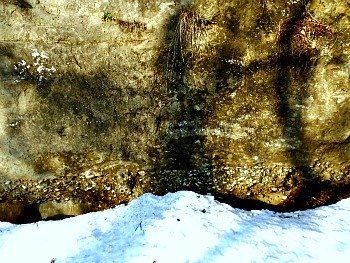
The layers of conglomerates that can be observed instead towards the edge of the rock wall are of massive aspect – that is, without structure – and are characterized by the presence of irregular sandstone intercalations, with an arrangement that changes considerably on the different vertical rocky transepts. These characteristics indicate that the sedimentation of the different materials happened following mass transportation of detritus, when a huge quantity of pebbles and sands were rapidly reversed; this type of accumulation represents therefore the result of a series of fossil fluvial floods.
The long strip of rock of the Pliocenic Rampart is in fact extended between a good section the Bologna Apennines; its most impressive parts, however, are without a doubt the mountains either side of the Savena and Zena valleys: Monte Adone (mentioned above), which is also perforated by several caves; the long ridge between the Savena and Zena streams – either side of the village of Livergnano, whose houses are literally grabbing the underlying bedrock, which is solid and yet malleable at the same time (see an image of Livergnano’s “hanging houses” below).
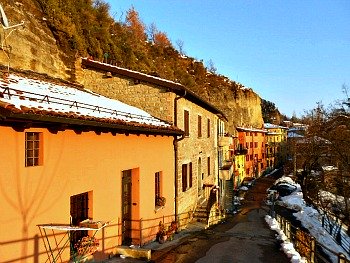
The Monte delle Formiche and the Raticosa Pass
The ridge then continues beyond the Zena valley, and reaches another notable peak: the Monte delle Formiche, 624 m – literally the Ant’s Mountain, where storms of flying ants go there to die every year in September (see picture below). This unusual event, which was never fully explained, has always called traditional pilgrimages to this mountain throughout the centuries; from the ants was once also derived an ointment which was reputed to have miraculous properties, and that in popular belief could cure many ailments.
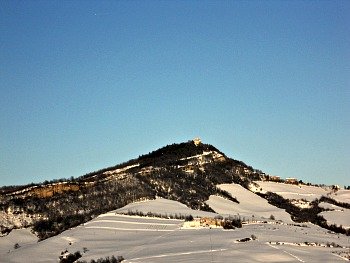
Proceeding to south of the province, one can reach the highest and most interesting section of the Bologna Apennines; the altitude is quite variable depending on where you’re heading to. To the south-west one encounters the most elevated part of the ridge, culminating at Corno alle Scale (1,985 metres; there will be a dedicated page on this section coming soon), while to the south-east the main ridge of the Bologna Apennines lowers itself considerably (and this is why you have the motorway and two important railway lines connecting north and south passing through here).
To the east of this busy corridor there are again some noteworthy patches of nature – especially around Passo della Raticosa (Raticosa Pass, 968 m), a low pass where during the 19th century was surely traced the Strada della Futa: a Napoleonic feat of engineering connecting Bologna and Florence – a very modern road at the time, which has by now become a relatively tranquil historic route (fortunately – as all the traffic uses the main thoroughfares described above).
There are – in the area around the pass – several rocky outcrops, which stand out from the surrounding, softer countryside. These are known as ophiolites – rocks of volcanic origin, often quite dark in colour, that rise sharply from the underlying clays and marls. Some such examples are the conical Rocca di Cavrenno (880 m; pictured below), nearby Sasso di San Zanobi (870 m; perhaps the most iconic of all) and the Sasso della Mantesca (about 800 m).
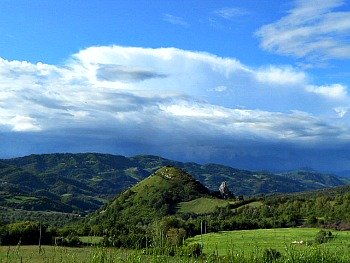
Situated at the border with Tuscany, in the region around the Raticosa Pass there are also a few mountains reaching above 1,000 metres, such as Monte Oggioli (1,290 m), Monte Canda (1,158 m), Sasso di Castro (1,276 m) and Monte Beni (1,236 m). They can all be climbed via mostly quiet paths among beech woodland, which can allow for interesting roundtrips; all of these peaks (but especially the latter one) also offer sweeping views, on one side, over the surrounding Northern Apennines and further beyond towards the faraway Po plains, while on the other side the views open up on a wide expanse of rolling green hills that – progressively lower in altitude – stretch all the way into Mugello, eventually leading down to Florence (see image below).
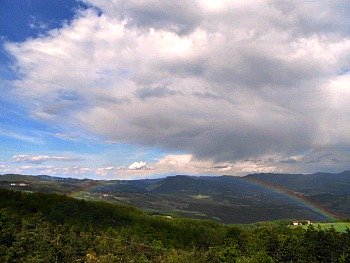
The flora of this area is interesting too. Despite not being very high in altitude, the plants found here are typical mountain species (the Raticosa pass is exposed to winds from all directions, but especially from the north and east; the local micro-climate is therefore generally quite gusty and cold). There is, in particular, an abundance of Orchids, which make this part of the Apennines particularly attractive in late spring, when most of them are in blossom (usually, the first half of May is the best, but there are oscillations from year to year; see below, for instance, a field peppered with Orchis morio – Green-winged Orchid, present both with a dominant purple and a much rarer white albino form; the second picture presents a detail of the same plant).
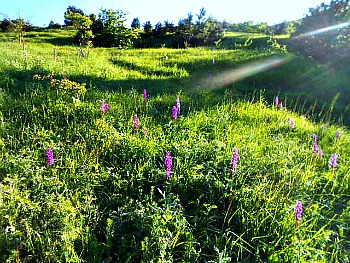
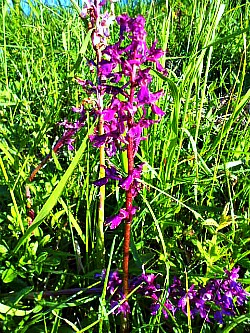
Another beautiful orchid to be seen in quite good numbers is Anacamptis pyramidalis (Pyramidal orchid; an image is presented below). It is a delicately scented orchid; compared to the previous species, this one is present in more localised stations, but it can be locally quite abundant.
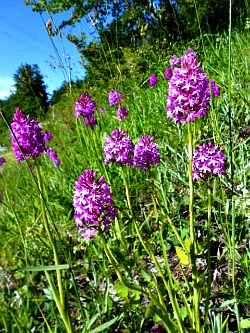
More outstanding and dramatic presences – but much rarer to see, in terms of orchids – include O. apifera, (Bee Orchid), which is pictured below.
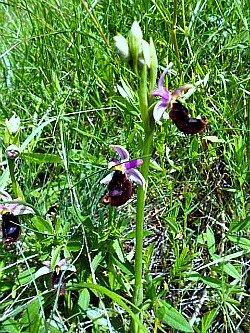
Other plants in the area include many typical low-altitude Alpine species; below is an image of Aquilegia vulgaris (Columbine), in blossom usually in late May-early June.
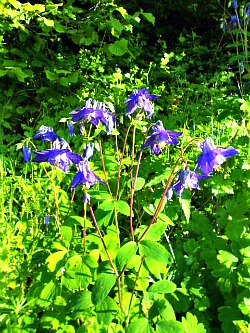
The Ophiolitic Rocks
The ophiolitic rocks (also more simply known as ophiolites) are an eerie sight, and one of the many natural treasures in the Apennines of Emilia-Romagna at large and of the Bologna Apennines in particular. Relatively rare within the region, the ophiolitic outcrops – fascinatingly rich, for their harsh beauty – vary from blocks of small dimensions to rock bodies of kilometric extension, with widths of – sometimes – hundreds of meters.
In the Emilia-Romagna, the ophiolites are particularly concentrated near the boundary with Liguria and, further east, with Tuscany – the area we are dealing with here. In these sectors of the Apennines there are a number of geological features, which surface in natural cross-sections, and that take on a noteworthy scientific, naturalistic and environmental interest – so that they can in fact be classified as ‘cultural heritage’; among these geological features, the ophiolitic rocks are no doubt the first item on the list, and still awaiting proper valorisation.
The ophiolites always constitute elements that strongly characterize the landscape: their black-green colour, sometimes red-brown; the dour outline of the relief (derived from the major resistance of erosion in respect to the surrounding rocks – usually of a clayey nature); the scarcity (or absence) of tree cover and the impossibility to be exploited as agricultural land: all these elements concur to easily identify the ophiolites in respect to the other rocks that compose the Northern Appennines.
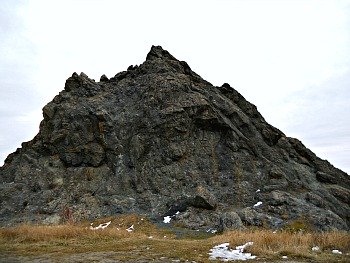
The Ophiolitic Sites Near the Raticosa Pass
This site is characterised by the presence of calcareous hills or mountains (such as Monte Canda and Monte Oggioli – which is portrayed in the picture below, taken from the village of Pietramala, near the Raticosa pass) and ophiolites (Rocca di Cavrenno, Sasso di San Zanobi, pictured above, Sasso della Mantesca and Monte Beni) – all emerging from a context with a strong connotation as traditional montane agro-pastoral landscape. This mountainous agricultural setting is partly affected by fast processes of abandonment and re-colonization by shrubs and trees that have originated a landscape very much like a mosaic, constituted by secondary pastured meadows, modest cultivated patches, shrubberies and woodland thickets on permanent meadows and on abandoned cultivated land, broadleaved woodland (mainly formed by oak and beech) and characteristic formations typical of the rocky crags, which often constitute geo-morphologic notable features.
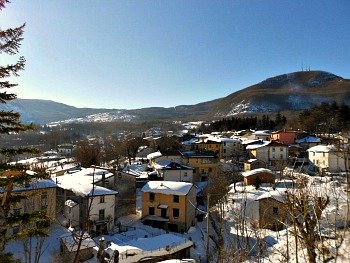
Among the most interesting habitats, one should at least mention the meadows on abandoned pastures on neuter-basic substrate and the meager meadows used for hay-making until the low altitudes – two habitats of regional interest, the first of which is also classified as a priority at European level. To be highlighted is also the sporadic presence of a flora typical of the ophiolite outcrops, with relic woodlands on the north-facing slopes.
This site is a fundamental part of one of the main stations in the area (at regional level) for various threatened bird populations, connected with the presence of secondary meadows and pasture lands, in regression at the moment or with an unknown trend. Among the species of major interest and deserving protection to be seen here are to be mentioned Short-toed Snake Eagle (Circaetus gallicus; ‘biancone’ in Italian) – nesting irregularly in the area – and Ortolan Bunting (Emberiza hortulana; ‘ortolano’ in Italian), present with one of its major Tuscan stations. There are also important populations of amphibians, connected with the permanence of an articulated system of temporary pools of drinking water for the livestock (in the picture below, a view of the ophiolitic outcrop of Monte Beni, again as seen from the village of Pietramala).
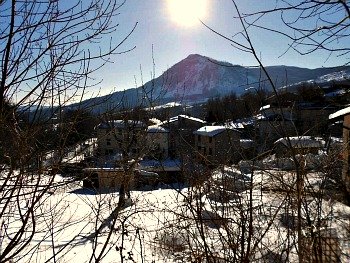
The Sasso di San Zanobi
The Sasso di San Zanobi (or San Zenobi) is a rock formation in the ‘Tosco-romagnolo’ sector of the Northern Apennines. It is situated in the small valley of the Diaterna stream, a short distance away from the Passo della Raticosa, in locality Caburaccia (municipality of Firenzuola). In this place there was also a small church (dedicated to San Zanobi), found in documents since 1299, but unfortunately it was destroyed during the war (the WW2 front passed very close to here).
The Sasso di San Zanobi is an ophiolite (a term derived from the Greek and composed of two words: ofis, snake, and lithos, rock – so snake-rock, because of the green and purple veins that run across it); it rises near the place where the church used to be, and where during the middle ages the Ubaldini family owned a castle. In this area are also found two other small mountains composed of iron, which have no affinity with the surrounding clayey landscape (the Sasso della Mantesca and the Rocca di Cavrenno, already mentioned above).
The Legend of San Zanobi. During the 4th century, the Bishop of Milan, St. Ambrose, met with the Bishop of Florence (San Zanobi) near Pietramala. Apparently, after this meeting there was an increase in conversions in the area between the Diaterna and the Idice valleys; according to legend, at that point the devil summoned a counsel in order to find a way to stop the conversions from happening, and proposed San Zanobi a bid: whoever lifted the largest boulder from the Idice riverbed and managed to bring it to the top of the hill would be the winner, and would ‘take’ all the souls in the area. San Zanobi accepted the bid; the devil therefore picked up a boulder, and with a lot of effort brought it uphill with him. San Zanobi then picked up a bigger boulder and lifted it easily, keeping it on his little finger and – taking over the devil – he deposited it in the location where it still is today. The devil, at that point – noticing he was losing the bid – became furious and threw his boulder, which smashed into many small pieces and burst into fire: this is the Sasso della Mantesca, which is situated a short distance away from the Sasso di San Zanobi, in the nearby Sillaro valley.
The Provincial Park of ‘La Martina’
Not far from the Sasso di San Zanobi and the other ophiolites, and located in the higher reaches of the Idice valley, the ‘La Martina’ park offers the ideal setting for quiet forest walks and open-air relaxation. An educational trail gives visitors greater understanding of the naturalistic aspects of the Northern Apennines, while the park is linked to an extensive network of paths, making it an excellent base for more extended trekking in the Bologna Apennines; in particular, there is a connection (from the Passo della Futa) with the long-distance route known as G.E.A. ('Great Apennine Excursion').
Gastronomy and Local Products
The woods of the Bologna Apennines offer the main ingredients for many of the traditional dishes of these mountains: mushrooms and truffles to begin with, both black and white. Thanks to its position, the gastronomy of this mountainous region combines the great tradition of Bolognese pasta dishes with flavoursome Tuscan influences; also, in the westernmost section of the Bologna Apennines, we can find two other specialities: the borlengo (a delicate, crumbly puff-pastry cooked in a copper pan known as ‘sole’; ‘sun’) and the tigella (more widespread in the Modena Appennines) – a thick round bread cooked in terracotta-fired molds (if you are interested to read more on the Borlengo and the Tigella, refer to the Zocca page).
The yearly grain-cycle and its resulting products are celebrated along the ‘Via del Pane’ (‘The Way of Bread’): a gastronomic itinerary in the Bologna Apennines that also includes a chance to visit water-mills, central to the rural economy of this region for centuries (see an image below of Mulino dell’Allocco – an ancient water-mill along the Savena valley), while a speciality worth trying is wheat beer.
Most of all, having been a staple of mountain diet throughout the Apennines for centuries, chestnuts are still central to many recipes, feasts and culinary celebrations; in some places of the Bologna Apennines even a chestnut beer (called Beltaine) is being produced.
For more information on the so-called chestnut civilization in the Northern Apennines please also refer to the Zocca page, where a short history of this very important staple food – and its implications in the cultural life of entire communities – has been drawn.
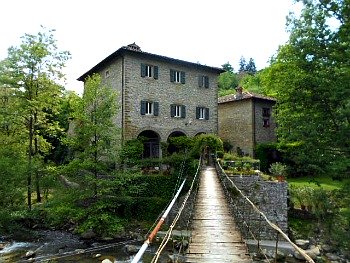
A Few Notes on the Minerals of the Bologna Apennines
The Geologic Composition of the Ophiolites
These are rocks of magmatic origin, historically well-known for their aspect and morphology. They look like enormous ‘floating’ boulders, emerging from the chaotic complex of clays – the so-called ‘argille scagliose’ – over which they were transported in geological times. For their aspect and colour, they were often called with typical and appropriate names – such as Sasso Nero, Sassi Rossi, Sasso Gurlino, and others. From a mineralogical point of view, they are important for the possible presence – inside them – of rare minerals, which are very interesting from a genetic perspective as well. The most conspicuous is the Datolite (a derivate from calcium), sought after for the beauty and the shiny appearance of its crystals – often hosted within the cavities of the ophiolitic varieties Gabbro and Serpentinite. Other minerals found and studied in the ophiolites include the copper sulphures (Chalcopyrite, Bornite, Chalcocite), of which the most remarkable find was in the Bisano Serpentinite, which also gave rise to a historic extractive activity in the area that lasted for more than twenty years, around the middle of the 19th century.
The most studied minerals for their rarity and the formational and geo-chemical aspects of the rocks hosting them are some species that contain nichel and titanium, which present themselves in minuscule but very beautiful cavities in the lithologic variety Hydrothermalite. The species containing nichel are Millerite, Jamborite and Vaesite; those containing titanium are Anatase and Brookite. Common species that can frequently be seen in the ophiolites are also: Quartz (in the Gabbro, Serpentinites and Hydrothermalites), found in beautiful crystals with different colours, from the limpid Hyaline gloss to shiny black; from the intense blue and red until the very rare Amethystine. Calcite and Dolomite display crystals of very different shapes – sometimes of a dark golden brown (esp. in Dolomite). Another typical mineral – but vary rare – is native copper, appearing either in small laminae or metallic ‘sponges’, and found in the cracks and cavities of some basalts.
Other Rocks and Minerals in the Bologna Apennines
In the geologic units that were described above one can also encounter several species of minerals. The genesis of these mineral compounds, which are often found in the shape of crystals, is connected to the digenetic processes – that is, the slow transformation of non-lithified sediments into rock, governed by elevated pressure and temperatures.
In the so-called Gessi Bolognesi (Bologna Chalks) one can find very beautiful crystals, of particular size and transparency, whose origin is secondary – that is, it was brought about by the circulation of fluids in the fractures following the formation by evaporation of chalk (or ‘selenite’) crystals (literally, the “moon rock”).
Beautiful, rose-like chalk crystals can be found in the Pliocenic clay too, while in sandstone it is possible to spot alabaster veins. But it is in the interior of the so-called “Argille Scagliose” (soft-layered clays) that the widest range of minerals is conserved: Calcite, Barite, Chalk, Pyrite are – among others – the mineralogical outfit of this most ancient geologic set.
Calcite (calcium carbonate) is very common and forms milk-white veins in the rocks; in the Ligurian body of rock one can also notice curious little bowl shapes – made out of this mineral – known as the ‘devil’s coins’. Iron-based minerals are quite frequent too; they are of a golden – or bronze-brown – colour because of chemical alterations, and can be seen in nodular aggregates of various dimensions.
Barite (‘barium sulphate’) is another mineral that can often be spotted in the calanchi; it can be found in the shape of white-greyish nodules of Mother-of-Pearl brilliance, with the accompanying presence of fibrous-radial crystals similar to calcite, distinguished by their specific weight due to high barium content (which also goes to explain the 19th century nickname of ‘heavy barium’).
The so-called Bologna barite (‘barium sulphate’), when heated up with a particular procedure in a well-lit environment, becomes phosphorescent; if taken to the sunlight, and then in the dark immediately after, it also glows for a while, and this property made it famous, widely sought-after and well-known – from the 17th century onwards – with the epithet of ‘phosphoric Bolognese stone’.
A difficult and lucky find is that of the ‘septaries’ – globular rock formations that can in fact reach remarkable dimensions. The name derives from the 'septa' that cross them: little ridges creating a sort of three-dimensional network that externally makes them appear – in the words of Bolognese scientist Luigi Bombicci – like “focacce (a typical Italian bread) tied up with a net of strings”.
The origin of the ‘septaries’ remains a geological riddle still to be fully solved; all we can say is that they are ‘digenetic concretions’ – that is, hard-cemented formations that owe their origins to the phases of fragmentation, dessiccation, deposition and crystallization which took place within particular portions of the main 'hosting' body of rock during digenesis (the rock-forming process).
Inside the ‘septaries’ small cavities with crystals can also be found, amongst which beautiful examples of other minerals such as Calcite, Barite, Quartz, Chalk, Aragonite and Pyrite may sometimes appear too.
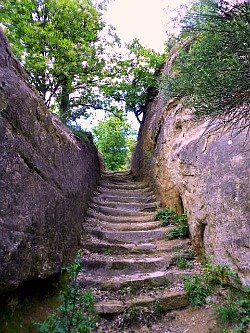
Trekking in the Bologna Apennines
The territory of the Bologna Apennines is covered by a wide-ranging network of well-indicated tracks (usually with the red-white striped CAI mark), and there are innumerable possible itineraries for every type of walker. The ‘Trail of Goethe and Montaigne’, for example – a trekking doubling the crossing of the Apennines by these historical figures, all the way from Bologna to Florence – winds through the whole length of the Bologna Apennines, following ancient routes such as the famous ‘Via degli Dei’ (‘Way of the Gods’) for part of the way (in the final picture above, the steps carved into the Pliocenic Rampart on the section that rises to the top of Rocca di Badolo, 475 m – an ancient site of worship along the ‘Via degli Dei’). Many itineraries can also be taken on horseback or ridden on a mountain bike.
There are also many museums and collections to complement and enrich a visit to the Bologna Apennines: in Monghidoro, for instance, is a small but interesting ‘Museo della Civiltà Contadina dell’Appennino’ (‘Museum of Apennine Mountain Culture’), while many others are dotted around throughout the region.
Return from Bologna Apennines to Northern Apennines
Return from Bologna Apennines to Italy-Tours-in-Nature
Copyright © 2013 Italy-Tours-in-Nature

New! Comments
Have your say about what you just read! Leave me a comment in the box below.